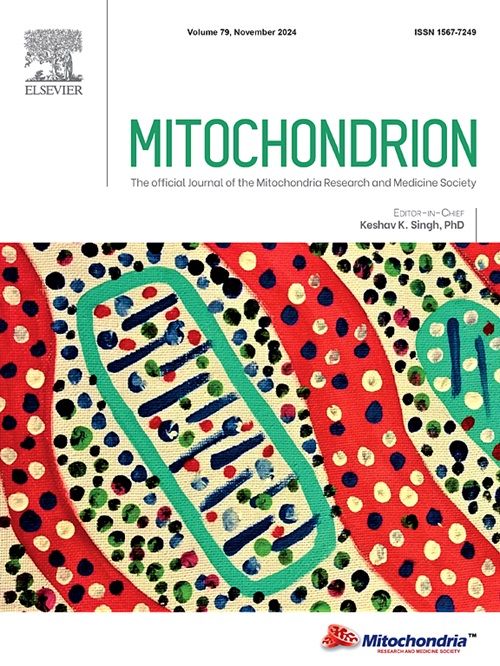线粒体DNA拷贝数与阿尔茨海默病和帕金森病的关系
IF 4.5
3区 生物学
Q2 CELL BIOLOGY
引用次数: 0
摘要
关于线粒体DNA拷贝数(mtDNA-CN)与阿尔茨海默病(AD)和帕金森病(PD)相关性的系统综述缺乏,其因果关系尚不清楚。目的:我们旨在对mtDNA-CN与AD和PD相关性的观察性研究进行系统回顾,并进行双向双样本孟德尔随机化(MR)研究,以探讨它们之间的因果关系。方法检索spubmed、Embase和Web of Science,检索2025年1月前符合条件的研究。以反方差加权法(IVW)为主要分析方法进行因果关系分析。结果14项病例对照研究和2项队列研究调查了mtDNA-CN与AD之间的关系,其中13项报告mtDNA-CN降低与AD风险增加相关,3项报告无显著相关性。所有研究(9个病例对照,1个横断面研究,2个队列研究)均观察到mtDNA-CN与PD之间的关系,除了3个研究报告无显著相关性。在MR分析中,遗传预测的mtDNA-CN与AD和PD无关,而遗传预测的AD (β - 0.085, 95% CI - 0.156 ~ - 0.013;P = 0.02),但PD与mtDNA-CN无关。敏感性和重复性分析显示了稳定的结果。系统评价发现mtDNA-CN与AD和PD的观察性研究有限,且大多数为病例对照研究。双向MR研究结果不支持mtDNA-CN在AD和PD发展中的因果关系,但发现AD可导致mtDNA-CN水平下降,这表明mtDNA-CN可能是AD的潜在生物标志物。本文章由计算机程序翻译,如有差异,请以英文原文为准。
Mitochondrial DNA copy number and Alzheimer’s disease and Parkinson disease
Introduction
A systematic review on the association of mitochondrial DNA copy number (mtDNA-CN) with Alzheimer’s disease (AD) and Parkinson disease (PD) is lacking and the causal relationship remains unclear.
Objective
We aimed to conduct a systematic review of observational studies on the association of mtDNA-CN with AD and PD and perform a bidirectional 2-sample Mendelian randomization (MR) study to investigate their causal relationships.
Methods
PubMed, Embase, and Web of Science were searched for eligible studies before Jan 2025. The causal links were conducted with inverse-variance weighted (IVW) method as the main analysis.
Results
Fourteen case-control and 2 cohort studies investigated the association between mtDNA-CN and AD, with 13 reporting decreased mtDNA-CN associated with increased risk of AD and 3 showing no significant association. All the studies (9 case-control, 1 cross-sectional, 2 cohort studies) observed the relation between mtDNA-CN and PD except for 3 studies reporting no significant association. In MR analysis, genetically predicted mtDNA-CN was not associated with AD and PD, whereas genetically predicted AD (β −0.085, 95 % CI −0.156 to −0.013; P = 0.02) but not PD was associated with mtDNA-CN. Sensitivity and replication analyses showed a stable finding.
Discussion
The systematic review found limited observational studies on mtDNA-CN and AD and PD and majority were case-control study. Findings of the bidirectional MR study did not support a causal effect of mtDNA-CN in the development of AD and PD but found that AD can lead to decreased levels of mtDNA-CN, which suggest mtDNA-CN as a potential biomarker of AD.
求助全文
通过发布文献求助,成功后即可免费获取论文全文。
去求助
来源期刊

Mitochondrion
生物-细胞生物学
CiteScore
9.40
自引率
4.50%
发文量
86
审稿时长
13.6 weeks
期刊介绍:
Mitochondrion is a definitive, high profile, peer-reviewed international research journal. The scope of Mitochondrion is broad, reporting on basic science of mitochondria from all organisms and from basic research to pathology and clinical aspects of mitochondrial diseases. The journal welcomes original contributions from investigators working in diverse sub-disciplines such as evolution, biophysics, biochemistry, molecular and cell biology, genetics, pharmacology, toxicology, forensic science, programmed cell death, aging, cancer and clinical features of mitochondrial diseases.
 求助内容:
求助内容: 应助结果提醒方式:
应助结果提醒方式:


